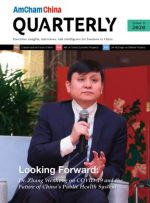Dr. Zhang Wenhong on COVID-19 and the Future of China’s Public Health System
By Yaxian Xiong

Dr. Zhang Wenhong is a Professor and head of the Center for Infectious Disease at Fudan University’s Huashan Hospital. He is also Chief of the Department of Internal Medicine at Fudan University, as well as the General Secretary of the Society of Infectious Diseases of the Chinese Medical Association and leads Shanghai’s COVII-19 clinical expert team.
Photo courtesy of Rhine Yuan
Dr. Zhang Wenhong, one of China’s foremost infectious disease experts, has played a critical role in China’s management of COVID-19. Followed by tens of millions of people on Chinese social media platforms, his opinions also wield great influence. Zhang spoke to the AmCham China Quarterly about getting COVID-19 under control, China’s public health system, and his hopes for the future of tackling infectious diseases.
The COVID-19 pandemic has been compared in scale to the devastating 1918 pandemic, considering the high fatality rate and the existence of a huge number of unverified cases. But what is perhaps most different in today’s crisis – more than 100 years later – is the fact that the pandemic is being controlled very differently between countries and across continents. Public health, of course, plays a very important role in the prevention and control of the disease. But there are three areas where those differences become most apparent: the determination of a country’s government; the effectiveness in communication between the government and the public; and the country’s basic public health capacity. One man who has been intimately involved in China’s healthcare response to the virus is Dr. Zhang Wenhong, and says China has been doing exactly the right thing in each of these three areas. “The public has always attached great importance to epidemic prevention. In our culture, we are accustomed to sacrificing our personal interests for the collective interest,” says Zhang. “As a result, during the worst of COVID-19, we have been wearing masks, complying with social distancing rules, and isolating ourselves at home.” But Zhang concedes that China “still cannot completely avoid the emergence of some sporadic cases,” and several Chinese cities have logged a handful of cases in recent months. However, these outbreaks were met with swift control, as the overall public health capacity in China has greatly improved this year. That said, it is not just China with fewer and fewer COVID-19 cases: in fact, many countries have recovered relatively well, such as Singapore and Japan.
Healthcare in China – and the World
“Adequate healthcare resources will contribute to a higher survival rate of COVID-19,” argues Zhang. “With adequate resources, the fatality rate could be reduced to around 1.5%.” China has a vast store of medical resources like PPE, and has a relatively efficient healthcare system. People don’t pay for individual COVID-19 treatment in China; rather, it is covered by public health insurance. China’s early control of COVID-19 proved very cost-effective. Several countries in Europe suffered high fatality rates mainly because of inadequate medical resource distribution. With adequate medical resources, Zhang adds that the fatality rate could be maintained at a level of 0.5%-0.7%. If the elderly populations are protected well, the fatality rate could be less than 0.7%, or about 3-4 times that of a typical flu. Zhang explains that people in the US were only admitted into hospitals once they were in emergency condition, and people without health insurance have had to pay for their treatment bills themselves. “China’s performance in battling COVID-19 is among the best in the world,” he says. “However, this does not mean that the high expenditure of health services and accessibility issues have been solved.”

Dr. Zhang poses with members of the AmCham China community after his talk in Beijing in December 2020.
Photo courtesy of Rhine Yuan
Cultural Differences
In one recent US-based survey, the willingness of respondents to get a COVID-19 vaccine was around 50%, showing cultural differences between ethnicities, with the willingness of those in Asian countries typically much higher. Most developed nations are aiming to provide vaccines to their high-risk populations in the first half of 2021 in order to reduce the hospitalization rate, therefore reducing the fatality rate. In China, vaccine promotion will be evident in schools and social distancing will still be maintained in public places. “The virus cycle for spread, contact, and reproduction is two weeks,” explains Zhang. “There have only been two examples where viruses like this have disappeared. One was SARS, which had a high morbidity rate. The other was H7N9, which had unsuccessful cross-species transmission. Humans are the biggest source of infection with regard to COVID-19. When the fatality rate is reduced to 0.5%, the whole world could be reopened.” A vaccine is quite important to China considering that medical resources need to be distributed to a population of 1.4 billion people. “There is no need to worry about the safety of the vaccines at this stage. However, post-market research of the vaccination will be needed. Normally it will take 6-12 months to verify the effectiveness of vaccines,” says Dr. Zhang. “The process of verifying the effectiveness needs to be conducted domestically. For now, interim analysis of the vaccines could help verify their effectiveness to some extent.”
Recovery, Growth, and Disease Prevention
“On the whole, I think the global impact of this epidemic is very significant, especially on industries that rely heavily on retail and business transactions,” says Dr. Zhang. “On the other hand, e-commerce companies or companies engaged in epidemic prevention may perform slightly better. Umbrellas sell better when it rains. But if the weather is good, no one buys an umbrella. Therefore, the world maintains a certain balance, but, generally speaking, if the lack of interaction between countries continues for a longer period of time, the global economy will take a significant hit.” Zhang also explains how everyone’s energy in China this year was mainly focused on the prevention and control of COVID-19. “When dealing with other diseases, public health centers continued to face many challenges. However, the development of COVID-19 has also had a positive impact on China. Firstly, China’s public health capacity has developed immensely since the start of the epidemic,” he says. “Secondly, society’s attention to public health has increased substantially. Thirdly, China has accumulated a lot of experience in the prevention and control of epidemics. Further down the line, China may invest more resources and energy into public health, using the experience gained from COVID-19 prevention for other infectious diseases. If this is done, I believe there will be incredible progress in the prevention and control of tuberculosis, AIDS, or hepatitis in China.” To Zhang, it’s clear that disadvantaged communities around the world are most at risk, not just during the current pandemic, but for all infectious diseases. He calls on “all sectors of society” to play their respective roles and work together to support these groups, which tend to see a particularly high rate of infectious diseases. “At some point, we will have COVID-19 under control, but controlling all infectious disease among the disadvantaged should become the main focus for 2021 and beyond.”

Dr. Zhang (left) engages in a fireside chat for Chamber members with AmCham China Chairman Greg Gilligan (right).
Photo courtesy of Rhine Yuan

This article is from the AmCham China Quarterly Magazine (Issue 4 2020). To access the entire publication for free, sign up on our member portal here.
